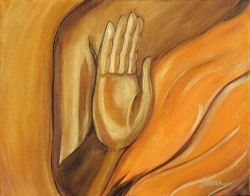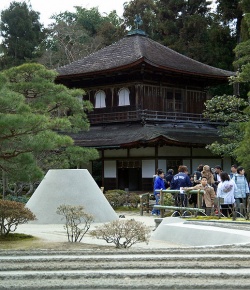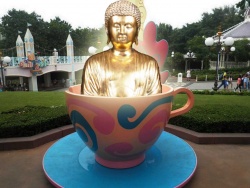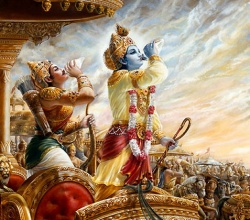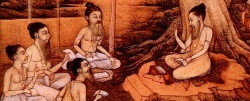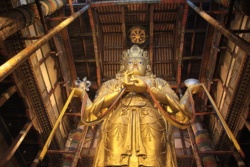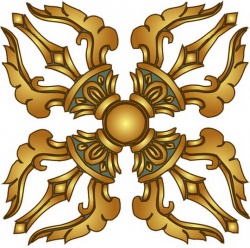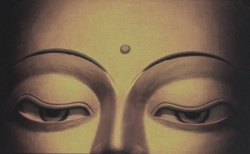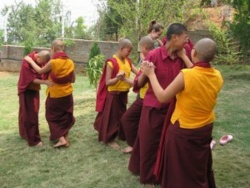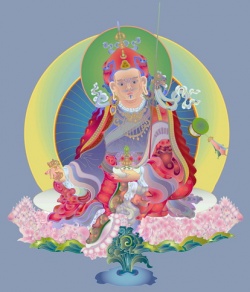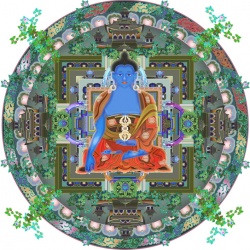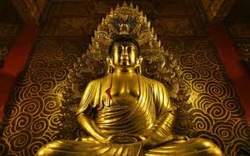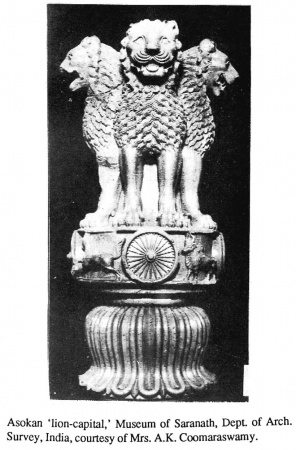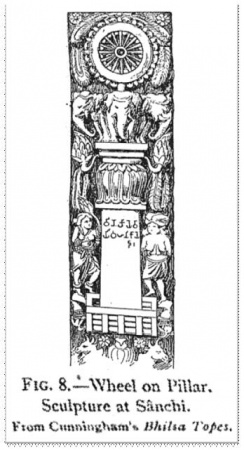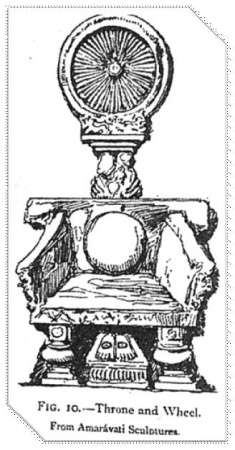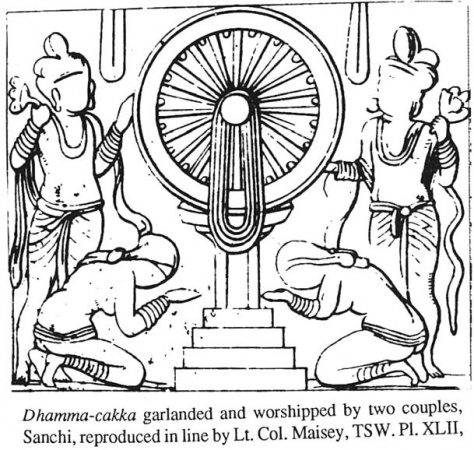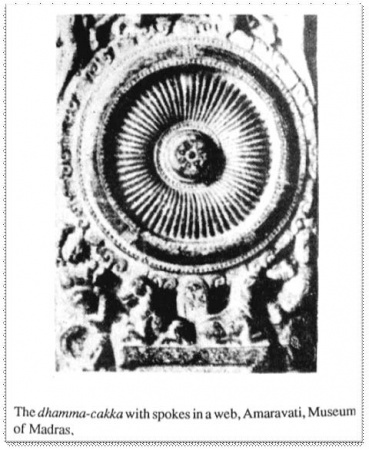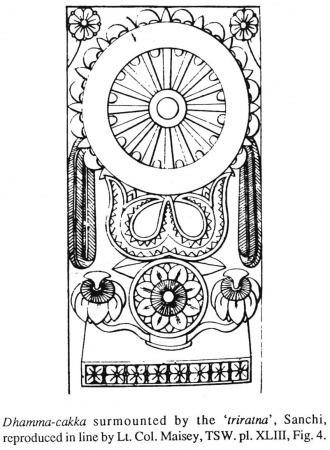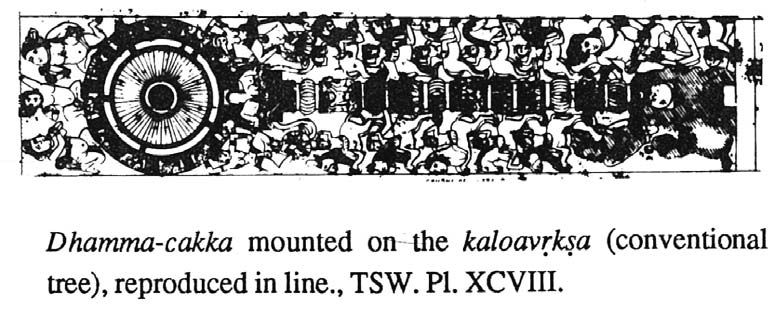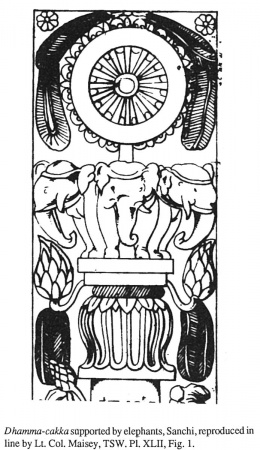Difference between revisions of "Dhamma Cakka (The Wheel of Law) : An important symbol of Buddhism by Prof. Dr. Bela Bhattacharya"
(linkss) |
|||
| Line 9: | Line 9: | ||
E-mail: bhattacharya_bela@yahoo.co.in}}<br/><br/> | E-mail: bhattacharya_bela@yahoo.co.in}}<br/><br/> | ||
| − | Man inerprets the non-visual world through shapes and forms acquired from the visual world of which he is a part. It is an attempt to express visually his innermost experience in terms of known experience. In this respect the symbols he creats are the outward manifestations of his inward spiritual existence. The wheel, or the `Cakra' we find in the Pre-Buddhist Indian literature, i.e. in the epic Mahābhārata, the legendary lord kçṣṇa, a manifestation of Visü, to have adorned a `Cakra', or `wheel' in the index finger of his right hand. According to Hindu mythology is manifested himself as kçṣṇa and Nārāyana, has been credited with the use of the Cakra to free the earth of the demons, representing evils, and the pious virtues, that is, the lawful canduct and normal behaviours on earth. The word Cakra, or wheel connotes to the clockwise cyclical forward motion, just like the wheel in a chariot, linking the peripheral to the center. It significs a circular object runs faster when put on rolling. So the "Dhamma Cakka" would mean to the "the righteous wheel" in cyclical forward motions towards the cosmic `Ultimate Reality'. At the early days Buddha is never represented in human forms but only by symbols. Instead Buddhist art comprising of his teachings as symbols such as the lotus, the Bodhi tree (tree of Enlightenment), footprints, lion horse, elephant, wheel of Law deer, Umbralla, stupa, etc. Buddhists adopted the cosmic wheel as a symbol with a different connotation. It is a challenging task to go in for presenting a realistic portrayal of the Dhamma Cakka (The wheel of Law) in Buddhism. It is undoubtedly a daunting task to make an indepth study of the wheel of Law (Dhamma- Cakka). I intend to confine our attention to Dhamma-Cakka : an important symbol of Buddhism. | + | Man inerprets the non-visual [[world]] through shapes and [[forms]] acquired from the [[visual]] [[world]] of which he is a part. It is an attempt to express visually his innermost [[experience]] in terms of known [[experience]]. In this [[respect]] the [[symbols]] he creats are the outward [[manifestations]] of his inward [[spiritual]] [[existence]]. The [[wheel]], or the `[[Cakra]]' we find in the Pre-Buddhist [[Indian]] {{Wiki|literature}}, i.e. in the {{Wiki|epic}} [[Mahābhārata]], the legendary lord kçṣṇa, a [[manifestation]] of Visü, to have adorned a `[[Cakra]]', or `[[wheel]]' in the index finger of his right hand. According to [[Hindu]] [[mythology]] is [[manifested]] himself as kçṣṇa and [[Nārāyana]], has been credited with the use of the [[Cakra]] to free the [[earth]] of the {{Wiki|demons}}, representing [[evils]], and the pious [[virtues]], that is, the lawful canduct and normal behaviours on [[earth]]. The [[word]] [[Cakra]], or [[wheel]] connotes to the {{Wiki|clockwise}} cyclical forward {{Wiki|motion}}, just like the [[wheel]] in a chariot, linking the peripheral to the center. It significs a circular [[object]] runs faster when put on rolling. So the "[[Dhamma]] [[Cakka]]" would mean to the "the righteous [[wheel]]" in cyclical forward motions towards the [[cosmic]] `[[Ultimate Reality]]'. At the early days [[Buddha]] is never represented in [[human]] [[forms]] but only by [[symbols]]. Instead [[Buddhist art]] comprising of his teachings as [[symbols]] such as the [[lotus]], the [[Bodhi tree]] ([[tree]] of [[Enlightenment]]), footprints, [[lion]] [[horse]], [[elephant]], [[wheel]] of Law {{Wiki|deer}}, Umbralla, [[stupa]], etc. [[Buddhists]] adopted the [[cosmic]] [[wheel]] as a [[symbol]] with a different connotation. It is a challenging task to go in for presenting a {{Wiki|realistic}} portrayal of the [[Dhamma]] [[Cakka]] (The [[wheel]] of Law) in [[Buddhism]]. It is undoubtedly a daunting task to make an indepth study of the [[wheel]] of Law ([[Dhamma]]- [[Cakka]]). I intend to confine our [[attention]] to Dhamma-Cakka : an important [[symbol of Buddhism]]. |
| − | The word Dhamma-Cakka is a compound word consis of two popular words, the dhamma and the Cakka. The word Dhamma-Cakka appears in the Pali Nikāyas and Vinaya texts without any expository comments either with the verbal form Pavetteti (Sets in motion) or without it and is interpreted variously in the commentaries. One of the earlier use of the term may be seen in the following verse of the Suttanipāta | + | The [[word]] Dhamma-Cakka is a compound [[word]] consis of two popular words, the [[dhamma]] and the [[Cakka]]. The [[word]] Dhamma-Cakka appears in the [[Pali]] [[Nikāyas]] and [[Vinaya]] texts without any expository comments either with the [[verbal]] [[form]] Pavetteti (Sets in {{Wiki|motion}}) or without it and is interpreted variously in the commentaries. One of the earlier use of the term may be seen in the following verse of the [[Suttanipāta]] |
<poem> | <poem> | ||
{{Nolinking|"Rājāhamasmi selāti | {{Nolinking|"Rājāhamasmi selāti | ||
| Line 19: | Line 19: | ||
</poem> | </poem> | ||
| − | From the verse it may be inferred that the Buddhists adopted the ancient Indian concept of Cakkavatti king or a king whose chariots wheel go onwards for the expansion of his kingdom. Perhaps the epithet of the [[Dhammarājā]] also was applied for the Buddha for the first time in Indian religious traditions and the wheel of his Dhammachariot was metaphorically called the Dhamma-Cakka. | + | From the verse it may be inferred that the [[Buddhists]] adopted the {{Wiki|ancient Indian}} {{Wiki|concept}} of [[Cakkavatti]] [[king]] or a [[king]] whose chariots [[wheel]] go onwards for the expansion of his {{Wiki|kingdom}}. Perhaps the [[epithet]] of the [[Dhammarājā]] also was applied for the [[Buddha]] for the first time in [[Indian]] [[religious]] [[traditions]] and the [[wheel]] of his Dhammachariot was {{Wiki|metaphorically}} called the Dhamma-Cakka. |
The following verse of the [[Samyuttanikāya]] confirms | The following verse of the [[Samyuttanikāya]] confirms | ||
| Line 29: | Line 29: | ||
</poem> | </poem> | ||
| − | A similar usage we see in the Mahāvagga (Vinayapiṭaka) : | + | A similar usage we see in the [[Mahāvagga]] ([[Vinayapiṭaka]]) : |
:{{Nolinking|"Dhamma-Cakkaü pavattetuü, gacchāmi kāsinaü puraü"}}<ref>{{Nolinking|[[Mahāvagga]] ([[Vinaya piṭaka]]).}}</ref> | :{{Nolinking|"Dhamma-Cakkaü pavattetuü, gacchāmi kāsinaü puraü"}}<ref>{{Nolinking|[[Mahāvagga]] ([[Vinaya piṭaka]]).}}</ref> | ||
| − | The above extracts of the Nikāyas explains that the meaning of the word dhammacakka was the wheel of the dhamma-chariot of the dhammarājā of Buddha (dhammarathassa cakkaü dhammacakkaü). | + | The above extracts of the [[Nikāyas]] explains that the meaning of the [[word]] [[dhammacakka]] was the [[wheel]] of the dhamma-chariot of the dhammarājā of [[Buddha]] (dhammarathassa cakkaü dhammacakkaü). |
| − | The aṭṭhakathās and the tīkās present different types of expositions of this word. In the Paṭisambhidāmagga and in its commentary and in the Commentary and the tikā of the [[Saüyuttanikāya]], some of the main points are as follows : The setting in motion of the wheel like dhamma is related to two types of knowledge : | + | The aṭṭhakathās and the [[tīkās]] {{Wiki|present}} different types of [[expositions]] of this [[word]]. In the [[Paṭisambhidāmagga]] and in its commentary and in the Commentary and the [[tikā]] of the [[Saüyuttanikāya]], some of the main points are as follows : The setting in {{Wiki|motion}} of the [[wheel]] like [[dhamma]] is related to two [[types of knowledge]] : |
| − | a) [[Paṭivedha-ñāṇa]] or the insight-knowledge which arose in regards to four noble truths when the Buddha was siting on the Bodhi-seat. | + | a) [[Paṭivedha-ñāṇa]] or the insight-knowledge which arose in regards to [[four noble truths]] when the [[Buddha]] was siting on the Bodhi-seat. |
| − | b) [[Desanā-ñāṇa]] or the knowledge exposed during the teaching of these four truths with twelve-fold methods at [[Isipatana]], [[Vārāṇasi]].<ref>{{Nolinking|Journal of the Department of Buddhist Studies, University of Delhi, Vol. xxvi, p. 31.}}</ref> | + | b) [[Desanā-ñāṇa]] or the [[knowledge]] exposed during the [[teaching]] of these [[four truths]] with twelve-fold methods at [[Isipatana]], [[Vārāṇasi]].<ref>{{Nolinking|Journal of the Department of Buddhist Studies, University of Delhi, Vol. xxvi, p. 31.}}</ref> |
| − | To depict Gotama's birth, mother [[Mahāmāyā]] was shown in the lotus with a white elephant coming towards her. | + | To depict [[Gotama's]] [[birth]], mother [[Mahāmāyā]] was shown in the [[lotus]] with a [[white elephant]] coming towards her. |
| − | {{Nolinking|(Uttara disato āgamma rajatadāma-vaṇṇāya saṇḍāya seta-padumaü gahetvā koñcanādaü naditvā kanaka-vimānaü pavisitvā mātu sayanaü tikkhattuü padakkhinaü katvā dakkhiṇa-passaü tālelvā kucchim paviṭṭha-sadiso ahosi)}}.<ref>{{Nolinking|The Dream of Queen Māyā, Jātaka-Nidāna Kathā.}}</ref> The Dream Queen Māyā. Jātaka Nidāna Kathā. | + | {{Nolinking|(Uttara disato āgamma rajatadāma-vaṇṇāya saṇḍāya seta-padumaü gahetvā koñcanādaü naditvā kanaka-vimānaü pavisitvā mātu sayanaü tikkhattuü padakkhinaü katvā dakkhiṇa-passaü tālelvā kucchim paviṭṭha-sadiso ahosi)}}.<ref>{{Nolinking|The Dream of Queen Māyā, Jātaka-Nidāna Kathā.}}</ref> The [[Dream]] [[Queen Māyā]]. [[Jātaka]] [[Nidāna]] [[Kathā]]. |
| − | His renunciation was shown by horse. {{Nolinking|(Evaü Bodhisatto pāsāda-talā otaritvā assasamīpaü gantvā ullaüghitvā Kanṭhakassa piṭṭhim abhirūhi)}}.<ref>{{Nolinking|[[Mahābhinikkhamanaü]] (Skt. [[Mahābhi-niṣkramaṇaü]]), [[Jātakanidāna-Kathā]].}}</ref> His Enlightenment was depicted by a vacant mound or throne under the Bodhi Tree. ([[Bodhi rukkhaükurehi]]).<ref>{{Nolinking|[[Jātaka-nidānakathā]].}}</ref> The [[Dhamma-cakkappavattana]] scene was depicted by Cakka (wheel) only. | + | His [[renunciation]] was shown by [[horse]]. {{Nolinking|(Evaü Bodhisatto pāsāda-talā otaritvā assasamīpaü gantvā ullaüghitvā Kanṭhakassa piṭṭhim abhirūhi)}}.<ref>{{Nolinking|[[Mahābhinikkhamanaü]] (Skt. [[Mahābhi-niṣkramaṇaü]]), [[Jātakanidāna-Kathā]].}}</ref> His [[Enlightenment]] was depicted by a vacant mound or [[throne]] under the [[Bodhi Tree]]. ([[Bodhi rukkhaükurehi]]).<ref>{{Nolinking|[[Jātaka-nidānakathā]].}}</ref> The [[Dhamma-cakkappavattana]] scene was depicted by [[Cakka]] ([[wheel]]) only. |
| − | The wheel of Dhamma is the most common symbol of veneration in Buddhism. Now I come to Paṭicca-samuppāda (Dependent Origination) which is the most fundamental principles of Buddhism is very closely related to cakka. | + | The [[wheel]] of [[Dhamma]] is the most common [[symbol]] of veneration in [[Buddhism]]. Now I come to [[Paṭicca-samuppāda]] ([[Dependent Origination]]) which is the most fundamental {{Wiki|principles}} of [[Buddhism]] is very closely related to [[cakka]]. |
| − | The outermost circle which is divided into twelve sections depicting the twelve stages of `Dependent Origination' (Paṭiccasamuppāda). Buddha discovered this eternal truth and solved the riddle of life and unravelled the mystry of being. The sections which are held at the root of all sufferings are twelve in number. It is called Dvādasa nidāna, Bhava Cakra. They are : | + | The outermost circle which is divided into twelve [[sections]] depicting the twelve stages of `[[Dependent Origination]]' ([[Paṭiccasamuppāda]]). [[Buddha]] discovered this eternal [[truth]] and solved the riddle of [[life]] and unravelled the mystry of being. The [[sections]] which are held at the [[root]] of all [[sufferings]] are twelve in number. It is called Dvādasa [[nidāna]], [[Bhava]] [[Cakra]]. They are : |
| − | :1) ignorance ([[avijjā]]) | + | :1) [[ignorance]] ([[avijjā]]) |
| − | :2) impression ([[saükhārā]]) | + | :2) [[impression]] ([[saükhārā]]) |
| − | :3) Consciousness ([[viññāna]]) | + | :3) [[Consciousness]] ([[viññāna]]) |
| − | :4) mind and matter ([[nāma-rūpa]]) | + | :4) [[mind]] and {{Wiki|matter}} ([[nāma-rūpa]]) |
| − | :5) six organs of sense ([[saëāyatana]]) | + | :5) [[six organs]] of [[sense]] ([[saëāyatana]]) |
| − | :6) contact ([[Phassa]]) | + | :6) [[contact]] ([[Phassa]]) |
| − | :7) feeling (vedanā) | + | :7) [[feeling]] ([[vedanā]]) |
| − | :8) desire (taṇhā) | + | :8) [[desire]] ([[taṇhā]]) |
| − | :9) attachment (upādāna) | + | :9) [[attachment]] ([[upādāna]]) |
| − | :10) existence (bhava) | + | :10) [[existence]] ([[bhava]]) |
| − | :11) birth (jāti) | + | :11) [[birth]] ([[jāti]]) |
| − | :12) old age death (jarāmaraṇa) | + | :12) [[old age]] [[death]] ([[jarāmaraṇa]]) |
| − | This is the wheel of life revolving day after day, from birth to death and death to birth. The complete causal formula specifies that : | + | This is the [[wheel of life]] revolving day after day, from [[birth]] to [[death]] and [[death]] to [[birth]]. The complete causal [[formula]] specifies that : |
<poem> | <poem> | ||
| − | Ignorance conditions impressions. | + | [[Ignorance]] [[conditions]] [[impressions]]. |
| − | Impressions condition consciousness. | + | [[Impressions]] [[condition]] [[consciousness]]. |
| − | Consciousness conditions mind and matter. | + | [[Consciousness]] [[conditions]] [[mind]] and {{Wiki|matter}}. |
| − | Mind and matter condition the six senses. | + | [[Mind]] and {{Wiki|matter}} [[condition]] the [[six senses]]. |
| − | The six senses condition contact | + | The [[six senses]] [[condition]] [[contact]] |
| − | Contact conditions feeling. | + | [[Contact]] [[conditions]] [[feeling]]. |
| − | Feeling conditions craving or desire. | + | [[Feeling]] [[conditions]] [[craving]] or [[desire]]. |
| − | Desire conditions attachment. | + | [[Desire]] [[conditions]] [[attachment]]. |
| − | Attachment conditions existence. | + | [[Attachment]] [[conditions]] [[existence]]. |
| − | Existence conditions birth. | + | [[Existence]] [[conditions]] [[birth]]. |
| − | Birth conditions old age and death. | + | [[Birth]] [[conditions]] [[old age]] and [[death]]. |
</poem> | </poem> | ||
| − | Buddha himself has declared, He who realises Pratityasamutpāda sees dharma (truth) and he who sees dharma (truth)sees Pratītya samutpāda. "Yo paṭiccasamuppādaü passati so dhammaü passati, yo dhammaü passati so paṭiccasamuppādaü passati ti."<ref>{{Nolinking|Majjhima Nikāya, P.T.S. Vol. 1, pp. 190-191.}}</ref> As the true way of the elements is presented here in the form of a circle or a wheel with twelve spokes, therefore, the dhamma-cakka clearly refers to the [[Paṭicca samuppāda]]. | + | [[Buddha]] himself has declared, He who realises [[Pratityasamutpāda]] sees [[dharma]] ([[truth]]) and he who sees [[dharma]] (truth)sees Pratītya [[samutpāda]]. "Yo paṭiccasamuppādaü passati so dhammaü passati, yo dhammaü passati so paṭiccasamuppādaü passati ti."<ref>{{Nolinking|Majjhima Nikāya, P.T.S. Vol. 1, pp. 190-191.}}</ref> As the true way of the [[elements]] is presented here in the [[form]] of a circle or [[a wheel]] with twelve spokes, therefore, the [[dhamma-cakka]] clearly refers to the [[Paṭicca samuppāda]]. |
| − | The Mahāvagga of the Vinaya-piṭaka refers that, after Enlightenment the Buddha contemplated the twelve-linked Paṭicca samuppāda in each watch of the night and exposed there the circle-like nature of all the elements of existence.<ref>{{Nolinking|Bodhikathā (Mahāvagga).}}</ref> | + | The [[Mahāvagga]] of the [[Vinaya-piṭaka]] refers that, after [[Enlightenment]] the [[Buddha]] contemplated the twelve-linked [[Paṭicca]] samuppāda in each watch of the night and exposed there the circle-like [[nature]] of all the [[elements]] of [[existence]].<ref>{{Nolinking|Bodhikathā (Mahāvagga).}}</ref> |
:{{Nolinking|"Paṭhama-yāme pubbe-nivāsa-ñānaü, majjhima-yāme dibba-cakkhuü visodhetvā, pacchima-yāme Paṭicca-samuppāde ñāṇaü otāresi.}}"<ref>{{Nolinking|Ibid.}}</ref> | :{{Nolinking|"Paṭhama-yāme pubbe-nivāsa-ñānaü, majjhima-yāme dibba-cakkhuü visodhetvā, pacchima-yāme Paṭicca-samuppāde ñāṇaü otāresi.}}"<ref>{{Nolinking|Ibid.}}</ref> | ||
| − | We find the same thing in the Milindapañho that the process of coming into existence, the process of cognition and all other aspects of our life are explained by the Buddha in the form of Cakka or circle by the method of [[Paṭicca-samuppāda]] : | + | We find the same thing in the [[Milindapañho]] that the process of coming into [[existence]], the [[process of cognition]] and all other aspects of our [[life]] are explained by the [[Buddha]] in the [[form]] of [[Cakka]] or circle by the method of [[Paṭicca-samuppāda]] : |
:{{Nolinking|"Evameva kho, Mahārāja, imāni Cakkāni vattāni bhagavatā, cakkhuñca paṭicca rupe ca uppajjati. Cakkhu-viññānaü...kammato puna cakkho jāyati".}}<ref>{{Nolinking|[[Milindapañho]], p. 51.}}</ref> | :{{Nolinking|"Evameva kho, Mahārāja, imāni Cakkāni vattāni bhagavatā, cakkhuñca paṭicca rupe ca uppajjati. Cakkhu-viññānaü...kammato puna cakkho jāyati".}}<ref>{{Nolinking|[[Milindapañho]], p. 51.}}</ref> | ||
| − | The Lalita-vistara also refers that the dharmacakra is the Pratītya-samutpāda, which avoids the two extremes of the annihilism and the eternalism and thus a mental state free from all false notions : | + | The [[Lalita-vistara]] also refers that the [[dharmacakra]] is the [[Pratītya-samutpāda]], which avoids the [[two extremes]] of the annihilism and the {{Wiki|eternalism}} and thus a [[mental state]] free from all false notions : |
{{Nolinking|Pratītyadharma otāramanu - cchedabhaṣṭā ṣṭavataü.}} | {{Nolinking|Pratītyadharma otāramanu - cchedabhaṣṭā ṣṭavataü.}} | ||
| Line 92: | Line 92: | ||
{{Nolinking|Sarvahristi samucchedo dharma cakramiti smritem.}}<ref>{{Nolinking|Lalitavistara, Verse no. 56.}}</ref> | {{Nolinking|Sarvahristi samucchedo dharma cakramiti smritem.}}<ref>{{Nolinking|Lalitavistara, Verse no. 56.}}</ref> | ||
| − | The twelve limbs of the Pratītya-samutpāda represent the twelve spokes of the circle or the wheel of existence : | + | The twelve limbs of the [[Pratītya-samutpāda]] represent the twelve spokes of the circle or the [[wheel of existence]] : |
{{Nolinking|Evaü hi dvādasākāraü dharma cakraü pravartita.}}<ref>{{Nolinking|Ibid, verse, 42.}}</ref> | {{Nolinking|Evaü hi dvādasākāraü dharma cakraü pravartita.}}<ref>{{Nolinking|Ibid, verse, 42.}}</ref> | ||
| − | The word [[dhamma-cakka]] is like a cakra or a wheel (circle), devoid of any absolute nature and dependent on causes and conditions for their existence (bhava). Thus the word dhamma occurring in the term dhamma cakka is to mean, in its original form, `nature' which again means `Law' the Law of `being' or `existence'Þa concept which had not been previously revealed to the world by any oneÞlet he even `deva, māra or brahma.' | + | The [[word]] [[dhamma-cakka]] is like a [[cakra]] or [[a wheel]] (circle), devoid of any [[absolute nature]] and dependent on [[causes and conditions]] for their [[existence]] ([[bhava]]). Thus the [[word]] [[dhamma]] occurring in the term [[dhamma]] [[cakka]] is to mean, in its original [[form]], `[[nature]]' which again means `Law' the Law of `being' or `existence'Þa {{Wiki|concept}} which had not been previously revealed to the [[world]] by any oneÞlet he even `[[deva]], [[māra]] or [[brahma]].' |
| − | The [[Divyāvadāna]] gives a description of the [[bhava-cakka]]. (The Divya vadāna, ed by Cowele and Neil, p. 300). Buddhist literature desercibes the universal monarch or the sovereign mover of the wheel (rājā cakkavatti) as a possessor of `seven treasures' (Satta-ratanāni) among which the `wheel treasure' is regarded as the most important. It is this wheel that, on the commend of Cakkavatti, moves round the world. The seven treasures possessed by a [[cakkavatti]] are [[cakka-ratana]] (the wheel treasure), [[hatthi-ratana]] (the elephant treasure), [[assa-ratana]] (the horse-treasure), [[mani-ratana]] (the gem-treasure) [[itthiratana]] (the consort-treasure), [[gahapati-ratana]] (the chief merchant-treasure), [[Parinayaka-ratana]] (counsellor-treasure). ([[Cakkavatti-sīhanāda sutta]], [[Dīgha-Nikāya]]). | + | The [[Divyāvadāna]] gives a description of the [[bhava-cakka]]. (The Divya vadāna, ed by Cowele and Neil, p. 300). [[Buddhist literature]] desercibes the [[universal monarch]] or the sovereign mover of the [[wheel]] ([[rājā]] [[cakkavatti]]) as a possessor of `[[seven treasures]]' (Satta-ratanāni) among which the `[[wheel treasure]]' is regarded as the most important. It is this [[wheel]] that, on the commend of [[Cakkavatti]], moves round the [[world]]. The [[seven treasures]] possessed by a [[cakkavatti]] are [[cakka-ratana]] (the [[wheel treasure]]), [[hatthi-ratana]] (the [[elephant treasure]]), [[assa-ratana]] (the horse-treasure), [[mani-ratana]] (the gem-treasure) [[itthiratana]] (the consort-treasure), [[gahapati-ratana]] (the chief merchant-treasure), [[Parinayaka-ratana]] (counsellor-treasure). ([[Cakkavatti-sīhanāda sutta]], [[Dīgha-Nikāya]]). |
| − | The Dhamma, the cosmic, and the righteous, forward moving force, was symbolically, conceived and rendered in art-forms as the Cakra (wheel) with spokes in it. Originally, the wheel, perhaps, had six spokes in it.<ref>{{Nolinking|David L. Snellgrove, The Image of the Buddha, p. 33.}}</ref> The spokes constituted and manifested a particular stage in the whole consmic cycle, of birth and re-birth, i.e. Saüsāra Cakraü through the symbolic Cakra. Besides, the four spokes in a Cakra represented the Four Noble Truths (Cattāri Ariya Saccāni) i.e. Suffering ([[Dhkkha]]), Origin of Suffering ([[Dukkha samudaya]]), Cessation of Suffering (Dukkha Nirodha) and the path that leads to the Cessation of suffering ([[Dukkha-Nirodha gāminī paṭipadā]]). | + | The [[Dhamma]], the [[cosmic]], and the righteous, forward moving force, was [[symbolically]], [[conceived]] and rendered in art-forms as the [[Cakra]] ([[wheel]]) with spokes in it. Originally, the [[wheel]], perhaps, had six spokes in it.<ref>{{Nolinking|David L. Snellgrove, The Image of the Buddha, p. 33.}}</ref> The spokes constituted and [[manifested]] a particular stage in the whole consmic cycle, of [[birth]] and [[re-birth]], i.e. Saüsāra Cakraü through the [[symbolic]] [[Cakra]]. Besides, the four spokes in a [[Cakra]] represented the [[Four Noble Truths]] ([[Cattāri Ariya Saccāni]]) i.e. [[Suffering]] ([[Dhkkha]]), Origin of [[Suffering]] ([[Dukkha samudaya]]), [[Cessation of Suffering]] ([[Dukkha Nirodha]]) and the [[path]] that leads to the [[Cessation of suffering]] ([[Dukkha-Nirodha gāminī paṭipadā]]). |
| − | This Four Nobole Truths were delivered by the Buddha to the five old friends, the Pañcavaggiyas after Enlightenment at Migdāye, Isipatana, Varaṇasī. This discourse is known as the Turning of the wheel of Law ([[Dhammacakkappavattana Sutta]]) symbolized by a wheel on lotus between a pair of deer. (Paṭhama dhamma desanā) which contains the ethical code of early Buddhism. It explains the four noble truths as mentioned above. The essence of this preaching is also known as the Middle Path (Majjhimapaṭipadā). It is also otherwise known as Ariya aṭṭhaïgika magga consisting of eight noble pathsÞright view (sammādiṭṭhi), right thought (sammā saïkappa), right speech (sammā vācā), right action (sammā kammanta), right livelihood (sammā ājīva), right effort (sammā vāyāma), right mindfulness (Sammā sati) and right concentration (sammā samādhi). Buddha came to realise that desire was the root of all evils that lead to repeated births and suffering. Once desires are extinguished one can rise above worldly temptations, one can get rid of births and its attendant desires and afflictions. | + | This Four Nobole [[Truths]] were delivered by the [[Buddha]] to the five old friends, the [[Pañcavaggiyas]] after [[Enlightenment]] at Migdāye, [[Isipatana]], Varaṇasī. This [[discourse]] is known as the Turning of the [[wheel]] of Law ([[Dhammacakkappavattana Sutta]]) [[symbolized]] by [[a wheel]] on [[lotus]] between a pair of {{Wiki|deer}}. ([[Paṭhama]] [[dhamma]] [[desanā]]) which contains the [[ethical]] code of [[early Buddhism]]. It explains the [[four noble truths]] as mentioned above. The [[essence]] of this preaching is also known as the [[Middle Path]] (Majjhimapaṭipadā). It is also otherwise known as [[Ariya]] aṭṭhaïgika [[magga]] consisting of eight [[noble]] pathsÞright view ([[sammādiṭṭhi]]), [[right thought]] ([[sammā]] saïkappa), [[right speech]] ([[sammā vācā]]), [[right action]] ([[sammā kammanta]]), [[right livelihood]] ([[sammā ājīva]]), [[right effort]] ([[sammā vāyāma]]), [[right mindfulness]] ([[Sammā sati]]) and [[right concentration]] ([[sammā samādhi]]). [[Buddha]] came to realise that [[desire]] was the [[root]] of all [[evils]] that lead to repeated [[births]] and [[suffering]]. Once [[desires]] are [[extinguished]] one can rise above [[worldly]] temptations, one can get rid of [[births]] and its attendant [[desires]] and [[afflictions]]. |
| − | The above eight spokes represented the eight fold path, and twenty-four spokes represented the paccayas, while the thirty-two spokes represented the Mahāpurisalakkhaṇas. Thus, the wheel or the circles, categorised as the uddesika,<ref>{{Nolinking|David L. Snellgrove, The Image of the Buddha, p. 44.}}</ref> connotes multiplicity of meanings, functions, and attributes. In its metaphysical mystical sencse, it signifies the true nature of reality, that is `[[śūnyatā]]', or Emptiness,<ref>{{Nolinking|Ibid. p. 425.}}</ref> reflecting like the mirror, the emphemeral naure of the Saüsāra,<ref>{{Nolinking|Ibid. p. 430.}}</ref> merged into oneness with the `Truth'. Sometimes the wheel has upto a thousand spokes, appearing like the sun, representing the bright clear Buddha's teaching the dispels the darkness of ignorance. Now I come the early significance of Buddhist art and sites identified are birth at Lumbini, enlightenment at Bodhagaya, first discourse at Sarnath and demise (Mahāparinibhāna) at kusinara, all of which took place under to tree of wisdom (Bodhi) that personified that goddess depicted as a radiant wheel. Four major events occurred in the life of Buddha i.e. birth, enlightenment, demise and Turning the wheel of Law symbolised by a wheel on lotus between a pair of deer. The wheel manifested itself on the Mauryan Pillar at Sarnath.<ref>{{Nolinking|A.S.I. Museum, Sarnath.}}</ref> The Buddha's First Sermon symbolised as a Cakrastambha (wheel) at Amaravati Stupa in Andhra Pradesh. This seulpture of about 100 A.D. is now preserved in the Government Museum, Madras (Chennai). | + | The above eight spokes represented the [[eight fold path]], and twenty-four spokes represented the paccayas, while the thirty-two spokes represented the Mahāpurisalakkhaṇas. Thus, the [[wheel]] or the circles, categorised as the [[uddesika]],<ref>{{Nolinking|David L. Snellgrove, The Image of the Buddha, p. 44.}}</ref> connotes multiplicity of meanings, functions, and [[attributes]]. In its [[metaphysical]] [[mystical]] sencse, it {{Wiki|signifies}} the [[true nature of reality]], that is `[[śūnyatā]]', or [[Emptiness]],<ref>{{Nolinking|Ibid. p. 425.}}</ref> {{Wiki|reflecting}} like the [[mirror]], the emphemeral naure of the Saüsāra,<ref>{{Nolinking|Ibid. p. 430.}}</ref> merged into [[oneness]] with the `[[Truth]]'. Sometimes the [[wheel]] has upto a thousand spokes, appearing like the {{Wiki|sun}}, representing the bright clear [[Buddha's teaching]] the dispels the {{Wiki|darkness}} of [[ignorance]]. Now I come the early significance of [[Buddhist art]] and sites identified are [[birth]] at [[Lumbini]], [[enlightenment]] at Bodhagaya, first [[discourse]] at [[Sarnath]] and demise (Mahāparinibhāna) at [[kusinara]], all of which took place under to [[tree of wisdom]] ([[Bodhi]]) that personified that [[goddess]] depicted as a radiant [[wheel]]. Four major events occurred in the [[life]] of [[Buddha]] i.e. [[birth]], [[enlightenment]], demise and [[Turning the wheel]] of Law symbolised by [[a wheel]] on [[lotus]] between a pair of {{Wiki|deer}}. The [[wheel]] [[manifested]] itself on the [[wikipedia:Maurya Empire|Mauryan]] Pillar at [[Sarnath]].<ref>{{Nolinking|A.S.I. Museum, Sarnath.}}</ref> The [[Buddha's]] First {{Wiki|Sermon}} symbolised as a Cakrastambha ([[wheel]]) at [[Amaravati]] [[Stupa]] in [[Andhra Pradesh]]. This seulpture of about 100 A.D. is now preserved in the Government Museum, [[Madras]] ([[Chennai]]). |
| − | In the earlier Buddhist Sculptures Buddha himself is not represented. At Amaravati an empty chair is shown, with the makrs of Buddha's feet on the footstool below, and the wheel indicated upon each of them. In the Siamese foot prints of Buddha, called the "Prabhat", on which there are one hundred and eight symbols, the wheel occupies a large and prominent space in the centre. The "thousand-ray'd wheel" on the soles of the feet is one of the marks on a child when born, indicating that he will either be a Chakravarti Rājā, or a perfect Buddha. Buddha also had these marks on his feet at his birth. As soon as he entered this world, he walked seven steps to each of the Cardinal points, and a lotus flower grew up at every step.<ref>{{Nolinking|Simpson William, Buddhist Praying wheel, pp. 42-43.}}</ref> | + | In the earlier [[Buddhist]] Sculptures [[Buddha]] himself is not represented. At [[Amaravati]] an [[empty]] chair is shown, with the makrs of [[Buddha's]] feet on the footstool below, and the [[wheel]] indicated upon each of them. In the [[Siamese]] foot prints of [[Buddha]], called the "Prabhat", on which there are one hundred and [[eight symbols]], the [[wheel]] occupies a large and prominent [[space]] in the centre. The "thousand-ray'd [[wheel]]" on the soles of the feet is one of the marks on a child when born, indicating that he will either be a [[Chakravarti]] [[Rājā]], or a {{Wiki|perfect}} [[Buddha]]. [[Buddha]] also had these marks on his feet at his [[birth]]. As soon as he entered this [[world]], he walked seven steps to each of the [[Cardinal points]], and a [[lotus flower]] grew up at every step.<ref>{{Nolinking|Simpson William, Buddhist Praying wheel, pp. 42-43.}}</ref> |
| − | In the bas reliefs on the gateways of Sanchi Stupa (first century B.C.), scenes from life of the Buddha find a prominent place. Buddha here is represented by symbols, such as horse but an umbrella held above, throne, foot-prints etc. But the wheel was placed in the highest position over the centre of the gate ways, the fragment of one still remains on the northern gate to show that this was the caseÞthus giving it the most important place amongst Buddhist symbols. Sometimes it is seen that on the top of a pillar; at others it is supported on a pedestal, and figures, including kinnaras,<ref>{{Nolinking|Kinnaras are a kind of celestial beings, "Divine Musicians", they are variously represented.}}</ref> are represenbed worshipping the wheel, and making offering to it.<ref>{{Nolinking|Simpsan William, Buddhist Praying wheel, pp. 40-41.}}</ref> | + | In the bas reliefs on the gateways of [[Sanchi]] [[Stupa]] (first century B.C.), scenes from [[life of the Buddha]] find a prominent place. [[Buddha]] here is represented by [[symbols]], such as [[horse]] but an [[umbrella]] held above, [[throne]], foot-prints etc. But the [[wheel]] was placed in the [[highest]] position over the centre of the gate ways, the fragment of one still remains on the northern gate to show that this was the caseÞthus giving it the most important place amongst [[Buddhist symbols]]. Sometimes it is seen that on the top of a pillar; at others it is supported on a pedestal, and figures, including [[kinnaras]],<ref>{{Nolinking|Kinnaras are a kind of celestial beings, "Divine Musicians", they are variously represented.}}</ref> are represenbed worshipping the [[wheel]], and making [[offering]] to it.<ref>{{Nolinking|Simpsan William, Buddhist Praying wheel, pp. 40-41.}}</ref> |
| − | The Dhamma Cakka has been found at Mathura. (The worship of Dhamma cakka). 1st century B.C. Archaeological Museum, Mathura, U.P. | + | The [[Dhamma]] [[Cakka]] has been found at [[Mathura]]. (The {{Wiki|worship}} of [[Dhamma]] [[cakka]]). 1st century B.C. {{Wiki|Archaeological}} Museum, [[Mathura]], U.P. |
| − | At Nasik in Vihara Cave no. 3 there are three symbols such as a Bodhi-Tree, a stupa and a Dhamma Cakka, witch worshippers on either side. The Caitya-hall at Karle in Maharastra belongs to a little ahead of the entrance two pillars. The pillar on the left stands on a wide cylindrical base, surmounted by a fell shaped capital on which were four lions supporting a Dhammacakka (now damaged). | + | At {{Wiki|Nasik}} in [[Vihara]] {{Wiki|Cave}} no. 3 there are three [[symbols]] such as a [[Bodhi-Tree]], a [[stupa]] and a [[Dhamma]] [[Cakka]], witch worshippers on either side. The Caitya-hall at Karle in {{Wiki|Maharastra}} belongs to a little ahead of the entrance two pillars. The pillar on the left stands on a wide cylindrical base, surmounted by a fell shaped capital on which were four [[lions]] supporting a [[Dhammacakka]] (now damaged). |
| − | It is obvious, that the wheel and lion, originally, were symbolic of the royalty and the virtues, i.e. the Dharma, embodied in it. Through the representations of the `wheel' and `lion', the kin was probably, trying to assert his responsibility for upholding the Dhamma. The Sarnath, Amarāvati, Sañci, Mathura, Nasik, Karla, Bharhut, Nāgārjuṇakoṇdā, Ajantā, Gāndhāra, all of the above mentioned Buddhist heritage sites reveal "the wheel" as its prized possession in the Buddhist arts. | + | It is obvious, that the [[wheel]] and [[lion]], originally, were [[symbolic]] of the royalty and the [[virtues]], i.e. the [[Dharma]], [[embodied]] in it. Through the {{Wiki|representations}} of the `[[wheel]]' and `[[lion]]', the kin was probably, trying to assert his {{Wiki|responsibility}} for upholding the [[Dhamma]]. The [[Sarnath]], [[Amarāvati]], Sañci, [[Mathura]], {{Wiki|Nasik}}, Karla, [[Bharhut]], Nāgārjuṇakoṇdā, Ajantā, [[Gāndhāra]], all of the above mentioned [[Buddhist]] heritage sites reveal "the [[wheel]]" as its prized possession in the [[Buddhist]] [[arts]]. |
| − | Having traced the origin and significance of the Dhamma-cakka, let us now see this Buddhist symbol became a National symbol in India. The wheel is the one above the capital of the Asoka column, a National Symbol. On 22 July 1947, Prime Minister of India Nehru moved the following Resolution in the constituent assembly : | + | Having traced the origin and significance of the [[Dhamma-cakka]], let us now see this [[Buddhist]] [[symbol]] became a National [[symbol]] in [[India]]. The [[wheel]] is the one above the capital of the [[Asoka]] column, a National [[Symbol]]. On 22 July 1947, [[Prime Minister]] of [[India]] Nehru moved the following Resolution in the constituent assembly : |
| − | "Resolved that the National Flag of India shall be horizontal tricolour of deep saffron, white and dark green in equal proportion. In the centre of the white band, there shall be a "wheel" in navy blue to present the "Cakra". The design of the wheel shall be that of the wheel (Cakra) which appears on the abacus of the Sarnath Lion Capital of Asoka. The diameter of the wheel shall he approximate to the width of the white band. The ratio of the width to the length of the Flag shall oridinarily be | + | "Resolved that the National [[Flag]] of [[India]] shall be horizontal tricolour of deep {{Wiki|saffron}}, white and dark green in {{Wiki|equal}} proportion. In the centre of the white band, there shall be a "[[wheel]]" in navy blue to {{Wiki|present}} the "[[Cakra]]". The design of the [[wheel]] shall be that of the [[wheel]] ([[Cakra]]) which appears on the abacus of the [[Sarnath]] [[Lion]] Capital of [[Asoka]]. The {{Wiki|diameter}} of the [[wheel]] shall he approximate to the width of the white band. The ratio of the width to the length of the [[Flag]] shall oridinarily be |
2-3."<ref>{{Nolinking|Journal of the Department of Buddhist Studies, University of Delhi, vol. xxvi, 2005, p. 124.}}</ref> | 2-3."<ref>{{Nolinking|Journal of the Department of Buddhist Studies, University of Delhi, vol. xxvi, 2005, p. 124.}}</ref> | ||
| − | Ulitimately, the Buddhist culture came to our rescue and we accepted the Dhamma-Cakka and lion Capital of Sarnath Asoka Pillar as National Symbols. It is a matter of great pride for the Buddhists that Dhamma Cakka now adorns the National Flag of India. | + | Ulitimately, the [[Buddhist]] {{Wiki|culture}} came to our rescue and we accepted the Dhamma-Cakka and [[lion]] Capital of [[Sarnath]] [[Asoka]] Pillar as National [[Symbols]]. It is a {{Wiki|matter}} of great [[pride]] for the [[Buddhists]] that [[Dhamma]] [[Cakka]] now adorns the National [[Flag]] of [[India]]. |
| − | In conclusion I may say that the fact stands out that the Buddha, in the Dhamma Cakka, were now being rendered to project the Enlightened Buddha as the physical embodiment of the cosmos, as well as being the propounder of the doctrine of law, signifying the beginning of the righteous moments and actions in the Universe. It meant the `phenomenal world' (Saüsāra) as well as the `Emptiness' ([[śūnyatā]]) merging into the primordial being of the Buddha. The Buddhist Philosophy of `Reality' rendered in art-forms and styles through the `wheel' or the Buddha, in Dhamma-Cakka, acquired, now, a great popularity, and a special status, too, in the realm of the Buddhist world.<ref>{{Nolinking|Ibid. p. 24.}}</ref> | + | In conclusion I may say that the fact stands out that the [[Buddha]], in the [[Dhamma]] [[Cakka]], were now being rendered to project the [[Enlightened Buddha]] as the [[physical]] [[embodiment]] of the [[cosmos]], as well as being the propounder of the [[doctrine]] of law, signifying the beginning of the righteous moments and [[actions]] in the [[Universe]]. It meant the `[[phenomenal world]]' (Saüsāra) as well as the `[[Emptiness]]' ([[śūnyatā]]) merging into the [[primordial]] being of the [[Buddha]]. The [[Buddhist Philosophy]] of `[[Reality]]' rendered in art-forms and styles through the `[[wheel]]' or the [[Buddha]], in Dhamma-Cakka, acquired, now, a great [[popularity]], and a special {{Wiki|status}}, too, in the [[realm]] of the [[Buddhist]] [[world]].<ref>{{Nolinking|Ibid. p. 24.}}</ref> |
| − | Buddhists adopted the cosmic wheel as a symbol with a different connotation. This wheel is regarded as the phenomenal wheel, i.e. Saüsāra-Cakka or bhava-Cakka. Both the wheels are regarded as identical and inseparable and are treated as having a common function. | + | [[Buddhists]] adopted the [[cosmic]] [[wheel]] as a [[symbol]] with a different connotation. This [[wheel]] is regarded as the [[phenomenal]] [[wheel]], i.e. Saüsāra-Cakka or bhava-Cakka. Both the [[wheels]] are regarded as [[identical]] and [[inseparable]] and are treated as having a common function. |
<gallery mode="packed" widths=300px heights=300px> | <gallery mode="packed" widths=300px heights=300px> | ||
| Line 146: | Line 146: | ||
:1. Dhamma-Cakka | :1. Dhamma-Cakka | ||
| − | :2. Symbol | + | :2. [[Symbol]] |
| − | :3. Buddha | + | :3. [[Buddha]] |
| − | :4. Bodhitree | + | :4. [[Bodhitree]] |
:5. Foot-print | :5. Foot-print | ||
| − | :6. Lions | + | :6. [[Lions]] |
:7. Bhava-Cakka | :7. Bhava-Cakka | ||
| − | :8. Noble-Eight fold Path | + | :8. Noble-Eight fold [[Path]] |
| − | :9. Paṭiccasamuppāda | + | :9. [[Paṭiccasamuppāda]] |
| − | :10. Buddhism | + | :10. [[Buddhism]] |
==Bibliography== | ==Bibliography== | ||
Revision as of 08:08, 9 March 2015
Dhamma Cakka (The Wheel of Law):
An important symbol of Buddhism
By
Prof. Dr. Bela Bhattacharya
University Professor of Pali
University of Calcutta
India
E-mail: bhattacharya_bela@yahoo.co.in
Man inerprets the non-visual world through shapes and forms acquired from the visual world of which he is a part. It is an attempt to express visually his innermost experience in terms of known experience. In this respect the symbols he creats are the outward manifestations of his inward spiritual existence. The wheel, or the `Cakra' we find in the Pre-Buddhist Indian literature, i.e. in the epic Mahābhārata, the legendary lord kçṣṇa, a manifestation of Visü, to have adorned a `Cakra', or `wheel' in the index finger of his right hand. According to Hindu mythology is manifested himself as kçṣṇa and Nārāyana, has been credited with the use of the Cakra to free the earth of the demons, representing evils, and the pious virtues, that is, the lawful canduct and normal behaviours on earth. The word Cakra, or wheel connotes to the clockwise cyclical forward motion, just like the wheel in a chariot, linking the peripheral to the center. It significs a circular object runs faster when put on rolling. So the "Dhamma Cakka" would mean to the "the righteous wheel" in cyclical forward motions towards the cosmic `Ultimate Reality'. At the early days Buddha is never represented in human forms but only by symbols. Instead Buddhist art comprising of his teachings as symbols such as the lotus, the Bodhi tree (tree of Enlightenment), footprints, lion horse, elephant, wheel of Law deer, Umbralla, stupa, etc. Buddhists adopted the cosmic wheel as a symbol with a different connotation. It is a challenging task to go in for presenting a realistic portrayal of the Dhamma Cakka (The wheel of Law) in Buddhism. It is undoubtedly a daunting task to make an indepth study of the wheel of Law (Dhamma- Cakka). I intend to confine our attention to Dhamma-Cakka : an important symbol of Buddhism.
The word Dhamma-Cakka is a compound word consis of two popular words, the dhamma and the Cakka. The word Dhamma-Cakka appears in the Pali Nikāyas and Vinaya texts without any expository comments either with the verbal form Pavetteti (Sets in motion) or without it and is interpreted variously in the commentaries. One of the earlier use of the term may be seen in the following verse of the Suttanipāta
"Rājāhamasmi selāti
dhammarājā anuttaro,
Dhammena Cakkaü vattemi
Cakkaü appativattiyaü".[1]
From the verse it may be inferred that the Buddhists adopted the ancient Indian concept of Cakkavatti king or a king whose chariots wheel go onwards for the expansion of his kingdom. Perhaps the epithet of the Dhammarājā also was applied for the Buddha for the first time in Indian religious traditions and the wheel of his Dhammachariot was metaphorically called the Dhamma-Cakka.
The following verse of the Samyuttanikāya confirms
"Ujuko nāma so maggo,
Abhayā nāma sā disā,
ratho akūjano nāma,
dhamma-Cakkehi saüyuto."[2]
A similar usage we see in the Mahāvagga (Vinayapiṭaka) :
- "Dhamma-Cakkaü pavattetuü, gacchāmi kāsinaü puraü"[3]
The above extracts of the Nikāyas explains that the meaning of the word dhammacakka was the wheel of the dhamma-chariot of the dhammarājā of Buddha (dhammarathassa cakkaü dhammacakkaü). The aṭṭhakathās and the tīkās present different types of expositions of this word. In the Paṭisambhidāmagga and in its commentary and in the Commentary and the tikā of the Saüyuttanikāya, some of the main points are as follows : The setting in motion of the wheel like dhamma is related to two types of knowledge :
a) Paṭivedha-ñāṇa or the insight-knowledge which arose in regards to four noble truths when the Buddha was siting on the Bodhi-seat. b) Desanā-ñāṇa or the knowledge exposed during the teaching of these four truths with twelve-fold methods at Isipatana, Vārāṇasi.[4]
To depict Gotama's birth, mother Mahāmāyā was shown in the lotus with a white elephant coming towards her.
(Uttara disato āgamma rajatadāma-vaṇṇāya saṇḍāya seta-padumaü gahetvā koñcanādaü naditvā kanaka-vimānaü pavisitvā mātu sayanaü tikkhattuü padakkhinaü katvā dakkhiṇa-passaü tālelvā kucchim paviṭṭha-sadiso ahosi).[5] The Dream Queen Māyā. Jātaka Nidāna Kathā.
His renunciation was shown by horse. (Evaü Bodhisatto pāsāda-talā otaritvā assasamīpaü gantvā ullaüghitvā Kanṭhakassa piṭṭhim abhirūhi).[6] His Enlightenment was depicted by a vacant mound or throne under the Bodhi Tree. (Bodhi rukkhaükurehi).[7] The Dhamma-cakkappavattana scene was depicted by Cakka (wheel) only.
The wheel of Dhamma is the most common symbol of veneration in Buddhism. Now I come to Paṭicca-samuppāda (Dependent Origination) which is the most fundamental principles of Buddhism is very closely related to cakka.
The outermost circle which is divided into twelve sections depicting the twelve stages of `Dependent Origination' (Paṭiccasamuppāda). Buddha discovered this eternal truth and solved the riddle of life and unravelled the mystry of being. The sections which are held at the root of all sufferings are twelve in number. It is called Dvādasa nidāna, Bhava Cakra. They are :
- 1) ignorance (avijjā)
- 2) impression (saükhārā)
- 3) Consciousness (viññāna)
- 4) mind and matter (nāma-rūpa)
- 5) six organs of sense (saëāyatana)
- 6) contact (Phassa)
- 7) feeling (vedanā)
- 8) desire (taṇhā)
- 9) attachment (upādāna)
- 10) existence (bhava)
- 11) birth (jāti)
- 12) old age death (jarāmaraṇa)
This is the wheel of life revolving day after day, from birth to death and death to birth. The complete causal formula specifies that :
Ignorance conditions impressions.
Impressions condition consciousness.
Consciousness conditions mind and matter.
Mind and matter condition the six senses.
The six senses condition contact
Contact conditions feeling.
Feeling conditions craving or desire.
Desire conditions attachment.
Attachment conditions existence.
Existence conditions birth.
Birth conditions old age and death.
Buddha himself has declared, He who realises Pratityasamutpāda sees dharma (truth) and he who sees dharma (truth)sees Pratītya samutpāda. "Yo paṭiccasamuppādaü passati so dhammaü passati, yo dhammaü passati so paṭiccasamuppādaü passati ti."[8] As the true way of the elements is presented here in the form of a circle or a wheel with twelve spokes, therefore, the dhamma-cakka clearly refers to the Paṭicca samuppāda.
The Mahāvagga of the Vinaya-piṭaka refers that, after Enlightenment the Buddha contemplated the twelve-linked Paṭicca samuppāda in each watch of the night and exposed there the circle-like nature of all the elements of existence.[9]
- "Paṭhama-yāme pubbe-nivāsa-ñānaü, majjhima-yāme dibba-cakkhuü visodhetvā, pacchima-yāme Paṭicca-samuppāde ñāṇaü otāresi."[10]
We find the same thing in the Milindapañho that the process of coming into existence, the process of cognition and all other aspects of our life are explained by the Buddha in the form of Cakka or circle by the method of Paṭicca-samuppāda :
- "Evameva kho, Mahārāja, imāni Cakkāni vattāni bhagavatā, cakkhuñca paṭicca rupe ca uppajjati. Cakkhu-viññānaü...kammato puna cakkho jāyati".[11]
The Lalita-vistara also refers that the dharmacakra is the Pratītya-samutpāda, which avoids the two extremes of the annihilism and the eternalism and thus a mental state free from all false notions :
Pratītyadharma otāramanu - cchedabhaṣṭā ṣṭavataü.
Sarvahristi samucchedo dharma cakramiti smritem.[12]
The twelve limbs of the Pratītya-samutpāda represent the twelve spokes of the circle or the wheel of existence :
Evaü hi dvādasākāraü dharma cakraü pravartita.[13]
The word dhamma-cakka is like a cakra or a wheel (circle), devoid of any absolute nature and dependent on causes and conditions for their existence (bhava). Thus the word dhamma occurring in the term dhamma cakka is to mean, in its original form, `nature' which again means `Law' the Law of `being' or `existence'Þa concept which had not been previously revealed to the world by any oneÞlet he even `deva, māra or brahma.'
The Divyāvadāna gives a description of the bhava-cakka. (The Divya vadāna, ed by Cowele and Neil, p. 300). Buddhist literature desercibes the universal monarch or the sovereign mover of the wheel (rājā cakkavatti) as a possessor of `seven treasures' (Satta-ratanāni) among which the `wheel treasure' is regarded as the most important. It is this wheel that, on the commend of Cakkavatti, moves round the world. The seven treasures possessed by a cakkavatti are cakka-ratana (the wheel treasure), hatthi-ratana (the elephant treasure), assa-ratana (the horse-treasure), mani-ratana (the gem-treasure) itthiratana (the consort-treasure), gahapati-ratana (the chief merchant-treasure), Parinayaka-ratana (counsellor-treasure). (Cakkavatti-sīhanāda sutta, Dīgha-Nikāya).
The Dhamma, the cosmic, and the righteous, forward moving force, was symbolically, conceived and rendered in art-forms as the Cakra (wheel) with spokes in it. Originally, the wheel, perhaps, had six spokes in it.[14] The spokes constituted and manifested a particular stage in the whole consmic cycle, of birth and re-birth, i.e. Saüsāra Cakraü through the symbolic Cakra. Besides, the four spokes in a Cakra represented the Four Noble Truths (Cattāri Ariya Saccāni) i.e. Suffering (Dhkkha), Origin of Suffering (Dukkha samudaya), Cessation of Suffering (Dukkha Nirodha) and the path that leads to the Cessation of suffering (Dukkha-Nirodha gāminī paṭipadā).
This Four Nobole Truths were delivered by the Buddha to the five old friends, the Pañcavaggiyas after Enlightenment at Migdāye, Isipatana, Varaṇasī. This discourse is known as the Turning of the wheel of Law (Dhammacakkappavattana Sutta) symbolized by a wheel on lotus between a pair of deer. (Paṭhama dhamma desanā) which contains the ethical code of early Buddhism. It explains the four noble truths as mentioned above. The essence of this preaching is also known as the Middle Path (Majjhimapaṭipadā). It is also otherwise known as Ariya aṭṭhaïgika magga consisting of eight noble pathsÞright view (sammādiṭṭhi), right thought (sammā saïkappa), right speech (sammā vācā), right action (sammā kammanta), right livelihood (sammā ājīva), right effort (sammā vāyāma), right mindfulness (Sammā sati) and right concentration (sammā samādhi). Buddha came to realise that desire was the root of all evils that lead to repeated births and suffering. Once desires are extinguished one can rise above worldly temptations, one can get rid of births and its attendant desires and afflictions.
The above eight spokes represented the eight fold path, and twenty-four spokes represented the paccayas, while the thirty-two spokes represented the Mahāpurisalakkhaṇas. Thus, the wheel or the circles, categorised as the uddesika,[15] connotes multiplicity of meanings, functions, and attributes. In its metaphysical mystical sencse, it signifies the true nature of reality, that is `śūnyatā', or Emptiness,[16] reflecting like the mirror, the emphemeral naure of the Saüsāra,[17] merged into oneness with the `Truth'. Sometimes the wheel has upto a thousand spokes, appearing like the sun, representing the bright clear Buddha's teaching the dispels the darkness of ignorance. Now I come the early significance of Buddhist art and sites identified are birth at Lumbini, enlightenment at Bodhagaya, first discourse at Sarnath and demise (Mahāparinibhāna) at kusinara, all of which took place under to tree of wisdom (Bodhi) that personified that goddess depicted as a radiant wheel. Four major events occurred in the life of Buddha i.e. birth, enlightenment, demise and Turning the wheel of Law symbolised by a wheel on lotus between a pair of deer. The wheel manifested itself on the Mauryan Pillar at Sarnath.[18] The Buddha's First Sermon symbolised as a Cakrastambha (wheel) at Amaravati Stupa in Andhra Pradesh. This seulpture of about 100 A.D. is now preserved in the Government Museum, Madras (Chennai).
In the earlier Buddhist Sculptures Buddha himself is not represented. At Amaravati an empty chair is shown, with the makrs of Buddha's feet on the footstool below, and the wheel indicated upon each of them. In the Siamese foot prints of Buddha, called the "Prabhat", on which there are one hundred and eight symbols, the wheel occupies a large and prominent space in the centre. The "thousand-ray'd wheel" on the soles of the feet is one of the marks on a child when born, indicating that he will either be a Chakravarti Rājā, or a perfect Buddha. Buddha also had these marks on his feet at his birth. As soon as he entered this world, he walked seven steps to each of the Cardinal points, and a lotus flower grew up at every step.[19]
In the bas reliefs on the gateways of Sanchi Stupa (first century B.C.), scenes from life of the Buddha find a prominent place. Buddha here is represented by symbols, such as horse but an umbrella held above, throne, foot-prints etc. But the wheel was placed in the highest position over the centre of the gate ways, the fragment of one still remains on the northern gate to show that this was the caseÞthus giving it the most important place amongst Buddhist symbols. Sometimes it is seen that on the top of a pillar; at others it is supported on a pedestal, and figures, including kinnaras,[20] are represenbed worshipping the wheel, and making offering to it.[21]
The Dhamma Cakka has been found at Mathura. (The worship of Dhamma cakka). 1st century B.C. Archaeological Museum, Mathura, U.P.
At Nasik in Vihara Cave no. 3 there are three symbols such as a Bodhi-Tree, a stupa and a Dhamma Cakka, witch worshippers on either side. The Caitya-hall at Karle in Maharastra belongs to a little ahead of the entrance two pillars. The pillar on the left stands on a wide cylindrical base, surmounted by a fell shaped capital on which were four lions supporting a Dhammacakka (now damaged).
It is obvious, that the wheel and lion, originally, were symbolic of the royalty and the virtues, i.e. the Dharma, embodied in it. Through the representations of the `wheel' and `lion', the kin was probably, trying to assert his responsibility for upholding the Dhamma. The Sarnath, Amarāvati, Sañci, Mathura, Nasik, Karla, Bharhut, Nāgārjuṇakoṇdā, Ajantā, Gāndhāra, all of the above mentioned Buddhist heritage sites reveal "the wheel" as its prized possession in the Buddhist arts.
Having traced the origin and significance of the Dhamma-cakka, let us now see this Buddhist symbol became a National symbol in India. The wheel is the one above the capital of the Asoka column, a National Symbol. On 22 July 1947, Prime Minister of India Nehru moved the following Resolution in the constituent assembly :
"Resolved that the National Flag of India shall be horizontal tricolour of deep saffron, white and dark green in equal proportion. In the centre of the white band, there shall be a "wheel" in navy blue to present the "Cakra". The design of the wheel shall be that of the wheel (Cakra) which appears on the abacus of the Sarnath Lion Capital of Asoka. The diameter of the wheel shall he approximate to the width of the white band. The ratio of the width to the length of the Flag shall oridinarily be 2-3."[22]
Ulitimately, the Buddhist culture came to our rescue and we accepted the Dhamma-Cakka and lion Capital of Sarnath Asoka Pillar as National Symbols. It is a matter of great pride for the Buddhists that Dhamma Cakka now adorns the National Flag of India.
In conclusion I may say that the fact stands out that the Buddha, in the Dhamma Cakka, were now being rendered to project the Enlightened Buddha as the physical embodiment of the cosmos, as well as being the propounder of the doctrine of law, signifying the beginning of the righteous moments and actions in the Universe. It meant the `phenomenal world' (Saüsāra) as well as the `Emptiness' (śūnyatā) merging into the primordial being of the Buddha. The Buddhist Philosophy of `Reality' rendered in art-forms and styles through the `wheel' or the Buddha, in Dhamma-Cakka, acquired, now, a great popularity, and a special status, too, in the realm of the Buddhist world.[23]
Buddhists adopted the cosmic wheel as a symbol with a different connotation. This wheel is regarded as the phenomenal wheel, i.e. Saüsāra-Cakka or bhava-Cakka. Both the wheels are regarded as identical and inseparable and are treated as having a common function.
Footnotes
- ↑ Sutta-nipāta, verse, 559.
- ↑ Samyutta-nikāya, vol. 1, p. 37.
- ↑ Mahāvagga (Vinaya piṭaka).
- ↑ Journal of the Department of Buddhist Studies, University of Delhi, Vol. xxvi, p. 31.
- ↑ The Dream of Queen Māyā, Jātaka-Nidāna Kathā.
- ↑ Mahābhinikkhamanaü (Skt. Mahābhi-niṣkramaṇaü), Jātakanidāna-Kathā.
- ↑ Jātaka-nidānakathā.
- ↑ Majjhima Nikāya, P.T.S. Vol. 1, pp. 190-191.
- ↑ Bodhikathā (Mahāvagga).
- ↑ Ibid.
- ↑ Milindapañho, p. 51.
- ↑ Lalitavistara, Verse no. 56.
- ↑ Ibid, verse, 42.
- ↑ David L. Snellgrove, The Image of the Buddha, p. 33.
- ↑ David L. Snellgrove, The Image of the Buddha, p. 44.
- ↑ Ibid. p. 425.
- ↑ Ibid. p. 430.
- ↑ A.S.I. Museum, Sarnath.
- ↑ Simpson William, Buddhist Praying wheel, pp. 42-43.
- ↑ Kinnaras are a kind of celestial beings, "Divine Musicians", they are variously represented.
- ↑ Simpsan William, Buddhist Praying wheel, pp. 40-41.
- ↑ Journal of the Department of Buddhist Studies, University of Delhi, vol. xxvi, 2005, p. 124.
- ↑ Ibid. p. 24.
Key Words
- 1. Dhamma-Cakka
- 2. Symbol
- 3. Buddha
- 4. Bodhitree
- 5. Foot-print
- 6. Lions
- 7. Bhava-Cakka
- 8. Noble-Eight fold Path
- 9. Paṭiccasamuppāda
- 10. Buddhism
Bibliography
- 1. Dīgha Nikāya, 3 vols; ed. by T.W. Rhys Davids and J. Estlin Carpenter. London, Pali Text Society, 1889-1910 reprn. 1983-1992.
- 2. Milindapañha, ed. by V. Trenckner, London, Pali Text Society, 1880, reprn. 1986.
- 3. Suttanipāta, ed. by Dines Anderson and Helmer Smith. London, Pali Text Society, 1965, reprn. 1990.
- 4. Facets of Early Buddhism (A Study of Fundamental Principles), Bhattacharya B. Dr. Sandhya Bhattacharya, Vill+P.O. Brindabanpur, P.S. Uluberia, Howrah, reprn. 2012.
- 5. Studies in Buddhism, Barua, B.M. Calcutta, Saraswati Library, 1974.
- 6. Political History of Ancient India, Roychoudhury, H.C. Calcutta, University of Calcutta, 1953.
- 7. Do & Stede, William ed. Pali English Dictionary, London, Luzac & Co. Ltd., 1966.
- 8. (The) Questions of King Milinda, Rhys Davids, T.W. and Stede, William, Delhi, Motilal Banarsidas, 1965.
- 9. Buddhist Praying Wheel, Simpson, W. London, Macmillan, 1896.
- 10. History of Indian Philosophy, Vol. 2 Sinha Jadunath, Calcutta, Sinha Publishing House, 1956.
- 11. Dependent Origination, Thera Piyadassi, Kandy, Buddhist Publication Society, 1959.
- 12. (The) Buddha's Ancient Path, Thera Piyadassi, Sri Lanka, Buddhist Publication Society, 1974.
- 13. Lalitavistara, Vaidya, P.L. Darbhanga, Mithila Institute, 1958.
- 14. (A) History of Indian Literature, Vol. 1-3. tr. V. Srinivas Sharma, tr. Subhadra Jha, Delhi, Motilal Banarsidas, 1963, Reprn. 1987.
- 15. The Image of the Buddha, Editor, David L. Snellgrove, New Delhi, Vikas Publishing House Pvt. Ltd.
- 16. Buddhist Symbolism of Wish-Fulfilment, Karunaratne Gunapala Senadeera, Delhi, Sri Satguru Publications, 1992.
Source
Buddhism And Australia Conference 2015 http://buddhismandaustralia.com/
